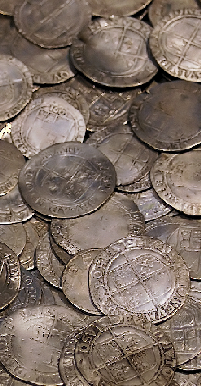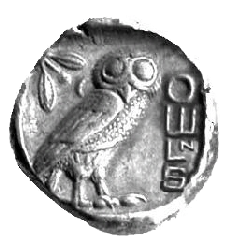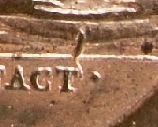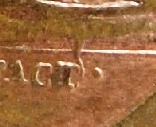
● Next Meeting Status:
Cancelled



● Host Society for the
BANS 2011 Congress
held in Southport


Where to next?

The Lancashire Halfpenny -
A Study Of A Fascinating Token Of 1794
The Lancashire Halfpenny, struck by the Soho Mint for Daniel Eccleston in August 1794, is listed in two varieties by Dalton and Hamer: DH57 and DH58. The comments attached to the catalogue listing suggest that Dalton and Hamer believed that DH58, lacking some of the reverse detail, was a later state of DH57, following an exercise in die polishing which removed a number of the finer features, including, most obviously, the period or stop following the word ‘COMMERCE’ in the exergual inscription on the reverse.
This form of listing is unusual for Dalton and Hamer, who more normally only assigned individual catalogue numbers to dies or die combinations which were recognisably different, rather than to different states of the same die. There may, therefore, be something to be learned from a reconsideration of this issue.

Background
The Lancashire Halfpenny was engraved by Noël-
The charge of five guineas for dies can be reasonably assumed to represent one pair of dies, an obverse and reverse, this being typical of the prices charged by Soho. In 1792, for example, the Sierra Leone Company was quoted ‘six to eight’ guineas for a pair of halfpenny dies – which in the event were not produced – and was actually charged ten guineas for a pair of dollar dies – of course, much bigger

So far, so good; one pair of dies paid for, one pair of dies listed. But there is
a difficulty. It is extremely unlikely that one pair of dies would be capable of
striking over a hundred thousand coins. One of the most serious on-
We can see an indication of the usage of dies in the halfpenny tokens struck by Soho for Henry Brownbill of Leeds. 172,233 tokens were struck in March and April 1793, and Dalton and Hamer list no fewer than eleven distinct reverse dies, of which six are described as ‘common,’ four ‘rare,’ and one ‘extremely rare.’ If we separate out the rare and extremely rare dies, we can see that six reverse dies were needed to produce around 170,000 coins, an approximate figure of just over 28,300 per die. This agrees well with Boulton’s earlier figures.

More than one Die?
On this basis, there ought to be three or four dies for the 109,000 Lancashire Halfpennies, and it is my suggestion that this is what actually happened, but that the fact has been obscured by changes and developments in Soho Mint practice.
The Leeds tokens were prepared from dies which were individually engraved. Although basically similar in layout and appearance, there are many minor differences in spacing, and detail, which allow for the identification of each individual die. Using these same criteria, it is understandable how Dalton & Hamer came to the conclusion that only one pair of dies was used for the Lancashire Halfpenny. There are several constant features. For example, the erratic positioning of the letters in the exergual inscription on the reverse is unchanging throughout the whole issue, and there is a flaw which runs from the ground beneath the plough to the final ‘T’ of the word ‘MANUFACT’ These would surely vary if more than one die was used?
Yes and no. If the dies had been individually engraved, as per Brownbill, then yes, they should vary. If, however, a master image had been prepared, and the dies multiplied from this, then no, not necessarily. We know that Boulton had been working on this process since Droz’s time, and that, by the time of the regal coinages of 1797 and onward, individual dies are not generally identifiable. It seems reasonable to take the die multiplication as a working hypothesis for this reconsideration.
There is no doubt that DH57 is the most complete variety of the Lancashire Halfpenny. There is detail in the sea behind the ship, plenty of detail in the ground beneath the plough, and, of course, there is the presence of the stop after ‘COMMERCE’ Since Dalton and Hamer, it has been assumed that the degraded impressions of DH58 were the result of enthusiastic polishing of the DH57 die.

Three Dies?
However we can now demonstrate that there are probably three, and conceivably more, different reverse dies for DH58. As a result of die multiplication, these show the constant features described above, but there are individual features which highlight the differences.
Two uncirculated specimens of DH58 from the author’s collection are illustrated here as Reverses 1 & 2, and a third example, Reverse 3, is reproduced, with permission, from Dr Gary Sriro’s Conder Images CD.
Hover your cursor to
see greater detail


Obverse & Reverse of
the Lancashire Halfpenny, DH58
engraved by Ponthon, struck at Soho, for Daniel Eccleston


Reverse 1
Flaw to ‘T’ of MANUFACT
Reverse 2
Flaw to ‘T’ of MANUFACT


Obverse & Reverse of a bronzed proof
of the Lancashire Halfpenny, DH57
engraved by Ponthon, struck at Soho, for Daniel Eccleston



Reverse 1
Reverse 2
Reverse 3

Reverse 1
Reverse 1 is from a die which shows relative freshness. Most of the detail remains in the ground beneath the plough, but there are two flaws which have developed in the die which mark it quite definitely. There is a chip on the edge adjacent to the second ‘A’ and extending past the 'S' and 'H' in LANCASHIRE which has resulted in a ‘cud’ being present on the strike, and there is a wandering die crack which starts in the rim of the coin and passes through the sternmost sail of the ship.
There is also one characteristic feature: the lowest rope in the rigging running from the bowsprit towards the foremast is incomplete. This is similar to, though rather greater in extent than, the gap in the rigging seen on DH57.

Reverse 1
Edge Chip & Cud

Reverse 1
Die Crack

Reverse 1
Bowsprit Rope

Reverse 2
Reverse 2 is from a die which appears to be rather more tired. Much of the detail in the ground beneath the plough is missing, and the exergual lettering is worn, showing signs of filling and flattening. It might be a later strike from the same die as Reverse 1 if it wasn't for the fact there is no sign of the edge break, and no sign of the die crack.
And to confirm the difference, on this die the lowest rope in the rigging from the bowsprit is complete.

Reverse 1
Clean Edge

Reverse 1
No Die Crack
Reverse 1
Bowsprit Rope


Reverse 3
Reverse 3 is from another relatively fresh die. Most of the detail remains in the ground beneath the plough, but there is no trace of either the cud on the upper left of the design, or the sail flaw. There is, however, an incipient break up of the die edge from the ‘Y’ of ‘HALFPENNY’ to the date, which does not occur on either of the other two dies.
The lowest rope from the bowsprit is, again, complete, as in Reverse 2

Reverse 3
Edge Cud

Reverse 3
Bowsprit Rope

Conclusions
So, without exhausting other possibilities, there appears to be a reasonable probability that there are three different reverse dies for DH58, and there may, of course, be more. Whether Reverse 1, with the incomplete rigging, is the descendant of the die for DH57 is not yet determined. Also open to question is whether the polishing, or whatever caused the loss of detail between DH57 and DH58, took place on the master, or on the working dies. Detailed study of more examples should produce a clearer picture. Equally, as Dalton and Hamer only commented on the reverse of DH58, this preliminary study pays no attention to the obverse dies.
The Lancashire Halfpenny is significant because it was the first large-
Incidentally, we should not necessarily be worried about the charge for only one pair of dies – Boulton often gave discounts on die production!
Chris Leather

Acknowledgements
The author would like to thank Dr Gary Sriro, of Villa Park, California [gsriro(at)sbcglobal.net] for his kind permission to use the illustration from his CD 'Conder Token Scans' which shows Reverse 3
The estimates of the number of Leeds and Lancashire tokens struck are taken from Dr R Doty's book 'Soho Mint and the Industrialisation of Money.'
